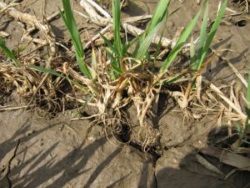Co-written by Dave Hooker, University of Guelph
Winter wheat can often be found to survive short freeze thaw events throughout the winter. However with the recent dips in temperatures with little to no snow cover, there are some concerns about crop damage and survivability. There is also some concern that more cycles of day-night freeze-thaw cycles in 2018 may be causing more frost heaving and unthrifty or dead plants once growth resumes. Incidentally, most winterkill occurs in Ontario under ice or frost heaving, rather than cold temperatures.
The risk of cold damage after the crop has come out of dormancy may increase when temperatures at the crown are below -10°C. Although many nighttime temperatures have been cool, the temperatures at the crown have likely been warmer than -10°C in many regions over the past two weeks. In regions where temperatures have dipped below -10°C for more than 48 hours, there has been some snow cover providing insulation to the crop.
It is important to walk your fields and assess the crop after a week or two of warm weather (if it ever arrives!), particularly those fields that may be at higher risk of winterkill. These fields include: those that were planted shallow, had frost heave problems (planted too shallow!)(figure) , planted with a variety that has poor winter hardiness, were planted late or had ponding throughout the winter.
When making winter wheat assessments for winter survival, fields should be walked in late April to early May after growth resumes, with the replant decision to another crop being made as late as possible. When evaluating wheat stands you need to count the number of plants per foot of row.

Figure : Winter wheat plants showing signs of frost heaving. Roots are not well anchored into the soil. Photo courtesy of Dave Hooker
Source : Field Crop News